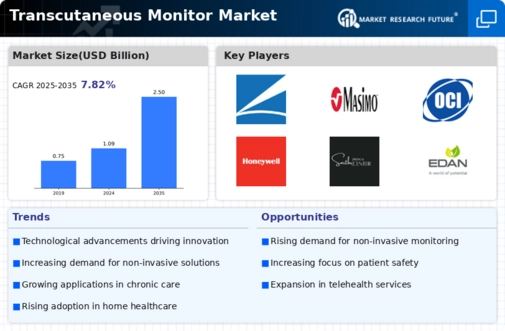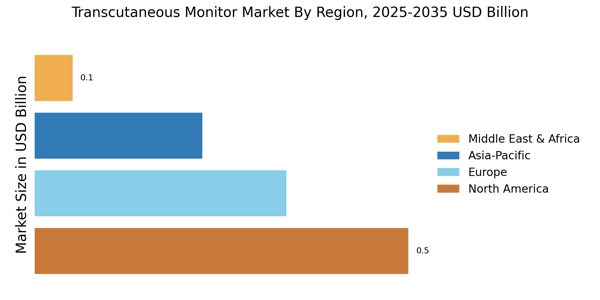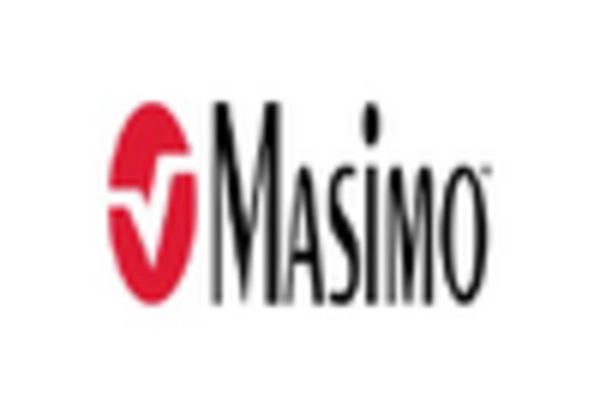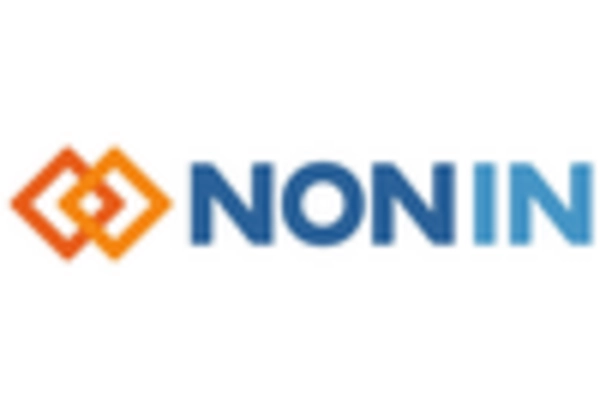Rising Prevalence of Chronic Diseases
The Transcutaneous Monitor Market is significantly influenced by the rising prevalence of chronic diseases, such as diabetes and cardiovascular disorders. These conditions necessitate continuous monitoring of patients' health parameters, thereby driving demand for transcutaneous monitoring solutions. Recent statistics indicate that chronic diseases account for nearly 70% of all deaths worldwide, underscoring the urgent need for effective monitoring tools. As healthcare providers seek to improve patient outcomes, the adoption of non-invasive monitoring technologies is becoming increasingly prevalent. This trend is expected to propel the growth of the Transcutaneous Monitor Market, as healthcare systems aim to implement more efficient and patient-friendly monitoring solutions. The focus on preventive care and early intervention further emphasizes the importance of transcutaneous monitors in managing chronic health conditions.
Increased Focus on Patient-Centric Care
The Transcutaneous Monitor Market is witnessing a paradigm shift towards patient-centric care, which emphasizes the importance of personalized treatment plans and improved patient engagement. Healthcare providers are increasingly recognizing the value of non-invasive monitoring solutions that empower patients to take an active role in managing their health. This shift is supported by data indicating that patient engagement can lead to better health outcomes and reduced healthcare costs. As a result, the demand for transcutaneous monitors is expected to rise, as these devices facilitate continuous monitoring and provide patients with real-time feedback on their health status. The growing emphasis on patient-centric care is likely to drive innovation within the Transcutaneous Monitor Market, leading to the development of more user-friendly and accessible monitoring solutions.
Growing Demand for Home Healthcare Solutions
The Transcutaneous Monitor Market is experiencing a notable increase in demand for home healthcare solutions, driven by the aging population and the desire for more convenient healthcare options. As more patients prefer to receive care in the comfort of their homes, the need for effective monitoring devices becomes paramount. Data suggests that the home healthcare market is projected to grow significantly, with a substantial portion of this growth attributed to the adoption of non-invasive monitoring technologies. Transcutaneous monitors are particularly well-suited for home use, as they provide reliable and accurate health assessments without the need for invasive procedures. This trend is expected to propel the Transcutaneous Monitor Market forward, as manufacturers focus on developing user-friendly devices that cater to the needs of home healthcare providers and patients alike.
Regulatory Support for Non-Invasive Technologies
The Transcutaneous Monitor Market is benefiting from increasing regulatory support for non-invasive monitoring technologies. Regulatory bodies are recognizing the advantages of non-invasive solutions in enhancing patient safety and comfort. This support is reflected in the streamlined approval processes for transcutaneous monitoring devices, which encourages manufacturers to innovate and bring new products to market. Recent regulatory changes have facilitated the introduction of advanced monitoring technologies, thereby expanding the range of available options for healthcare providers. As regulatory frameworks continue to evolve, the Transcutaneous Monitor Market is likely to experience accelerated growth, driven by the introduction of innovative and compliant monitoring solutions that meet the needs of both patients and healthcare professionals.
Technological Advancements in Monitoring Devices
The Transcutaneous Monitor Market is experiencing a surge in technological advancements that enhance the accuracy and efficiency of monitoring devices. Innovations such as improved sensor technology and advanced algorithms are enabling more precise measurements of physiological parameters. For instance, the integration of wireless connectivity allows for real-time data transmission, facilitating timely clinical decisions. According to recent data, the market for advanced monitoring devices is projected to grow at a compound annual growth rate of approximately 8% over the next five years. This growth is driven by the increasing need for reliable and efficient monitoring solutions in various healthcare settings, including hospitals and outpatient facilities. As technology continues to evolve, the Transcutaneous Monitor Market is likely to witness further enhancements that could redefine patient care.


















Leave a Comment